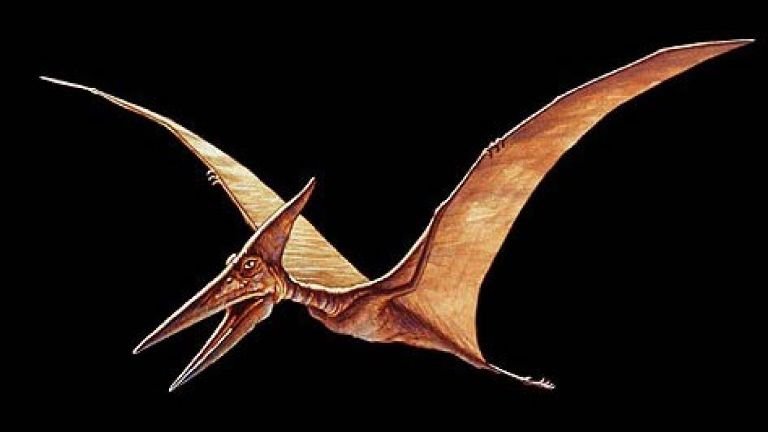
Their wide wing membranes probably included and connected the hind legs. COURTESY
Pterosaurs were flying reptiles of the extinct clade or order Pterosauria. They existed during most of the Mesozoic: from the late Triassic to the end of the Cretaceous (228 to 66 million years ago). Pterosaurs are the earliest vertebrates known to have evolved powered flight. Their wings were formed by a membrane of skin, muscle, and other tissues stretching from the ankles to a dramatically lengthened fourth finger.
There were two major types of pterosaurs. Basal pterosaurs (also called ‘non-pterodactyloid pterosaurs’ or ‘rhamphorhynchoids’) were smaller animals with fully toothed jaws and, typically, long tails. Their wide wing membranes probably included and connected the hind legs. On the ground, they would have had an awkward sprawling posture, but their joint anatomy and strong claws would have made them effective climbers, and they may have lived in trees. Basal pterosaurs were insectivores or predators of small vertebrates. Later pterosaurs (pterodactyloids) evolved many sizes, shapes, and lifestyles. Pterodactyloids had narrower wings with free hind limbs, highly reduced tails, and long necks with large heads. On the ground, pterodactyloids walked well on all four limbs with an upright posture, standing plantigrade on the hind feet and folding the wing finger upward to walk on the three-fingered “hand”. They could take off from the ground, and fossil track ways show at least some species were able to run and wade or swim. Their jaws had horny beaks, and some groups lacked teeth. Some groups developed elaborate head crests with sexual dimorphism.
The anatomy of pterosaurs was highly modified from their reptilian ancestors by the adaptation to flight. Pterosaur bones were hollow and air-filled, like those of birds. This provided a higher muscle attachment surface for a given skeletal weight. The bone walls were often paper-thin. They had a large and keeled breastbone for flight muscles and an enlarged brain able to coordinate complex flying behaviour. Pterosaur skeletons often show considerable fusion. In the skull, the sutures between elements disappeared. In some later pterosaurs, the backbone over the shoulders fused into a structure known as a notarium, which served to stiffen the torso during flight, and provide a stable support for the shoulder blade. Likewise, the sacral vertebrae could form a single synsacrum while the pelvic bones fused also. The two groups overlapped in time, but the earliest pterosaurs in the fossil record are basal pterosaurs, and the latest pterosaurs are pterodactyloids.
The position of the clade Anurognathidae (Anurognathus, Jeholopterus, Vesperopterylus) is debated. Anurognathids (frog-headed pterosaurs) were highly specialized. Small flyers with shortened jaws and a wide gap, some had large eyes suggesting nocturnal or crepuscular habits, mouth bristles, and feet adapted for clinging. Parallel adaptations are seen in birds and bats that prey on insects in flight. Pterosaurs had a wide range of sizes. Generally they were rather large. Even the smallest species had a wingspan no less than 25 centimetres (10 inches). The most sizeable forms represent the largest known animals ever to fly, with wingspans of up to 10–11 metres (33–36 feet). Standing, such giants could reach the height of a modern giraffe. Traditionally, it was assumed that pterosaurs were extremely light relative to their size. Later, it was understood that this would imply unrealistically low densities of their soft tissues. Some modern estimates therefore extrapolate a weight of up to 250 kilograms (550 pounds) for the largest species.






0 Comments